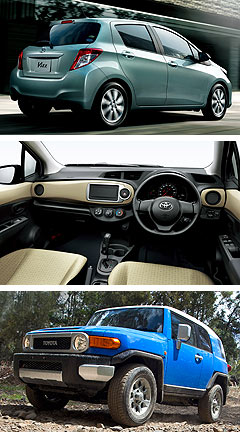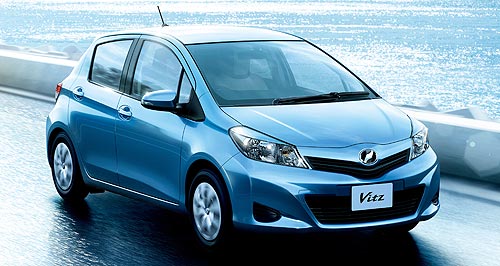Future models - Toyota - YarisNew Toyota Yaris set to come from JapanFresh metal: The MY2011 Yaris is among several new Toyota models planned for launch this year. Toyota sticks with Japanese sourcing for 2011 Yaris – at least for starters10 Jan 2011 TOYOTA will continue to import its popular Yaris light car from Japan when its next generation arrives in Australia in about September, going against the industry trend to switch to cheaper sources such as Thailand for entry level vehicles. But the world’s number one car-maker has not ruled out an eventual switch to a low-cost Asian source for its Australian stocks of Yaris in the life of the new model, which has just been launched in Japan under the Vitz badge. The latest Yaris will be one of the new-model highlights of a big 2011 for Toyota Australia, which endured something of a fresh-metal drought in 2010. As well as the new baby of its range, the market leader will launch its retro-styled, Prado-based niche four-wheel-drive FJ Cruiser in March and the all-new locally made Camry in the final quarter of the year. As well, it will counter the rash of new one-tonne ute models from competitors by giving its top-selling HiLux a “big technical update” that almost certainly will include extending electronic stability control (ESC) to all models, matching new arrivals such as the VW Amarok, Ford Ranger and Mazda BT-50.  Toyota Australia senior executive director for sales and marketing, David Buttner, said Toyota was essentially at the end of its current generation of models, but was now about to start on a new-model journey over the next two years. That new cycle would include a new hybrid Camry in early 2012 – a few months after the conventional petrol Camry with a new 2.5-litre engine – along with a small hybrid car, thought to be the Corolla-based Auris petrol-electric hatch from Europe. Mr Buttner ruled out a hybrid version of the new Yaris in the immediate future, and has also dismissed suggestions of a switch to Thai manufacture for the smallest Toyota currently offered on the Australian market. He confirmed that the new-generation car would come from its current supply base in Japan, but indicated that Toyota Australia was pushing for a more affordable supply option. “It is TMC’s (Toyota Motor Corporation) call – they decide where the cars are made,” he said. “We can only let them know our views.” Mr Buttner has said on several occasions that Toyota Australia would like to see Toyota explore lower-cost manufacturing options for smaller cars in the range. The Toyota Yaris – pipped for light-car sales supremacy in 2010 by Hyundai’s Getz that is now in run-out – now faces competition from a raft of competitors made in low-cost centres such as Thailand, South Korea, India, Malaysia and, from this year, China. Thai-built vehicles, including the Mazda2, Ford Fiesta, Nissan Micra and Honda Jazz/City, all enjoy tariff-free entry to Australia under our country’s free-trade agreement with Thailand, while the Yaris and other Japanese-made vehicles face a five per cent import slug. Similarly, the Japanese-made Toyota Corolla – Australia’s top-selling small car for 11 straight years – is at a wholesale-price disadvantage to cars made in low-cost countries, such as South Korea – source of the Hyundai i30. This year, the Corolla also will face competition from Holden’s locally made Cruze, which will have no tariff or shipping burdens and a marketing advantage with local fleets that have “buy local” policies. However, Mr Buttner said Toyota would do whatever it needed to do to keep value for money in its products. “Looking to the future, we have no intention of ceding ground to those who would take our market share,” he said. Mr Buttner said that while the company would not get hung up on any particular product making it to number one in the market, Toyota regarded its overall market leadership as “extremely important”. “We have a very large car park out there, and we have 248 dealers,” he said. “They have a significant investment in the franchise, and those dealers have invested in capability and capacity over many years. “If you look at just the last five years alone, the average investment has been $90 million per year – facilities, employing people. “We have a huge onus of responsibility to those dealers, as a factory, to ensure that we maintain the dominant position in the marketplace so they get the volume throughput to get a return on the investment they have made. “As the factory guy in charge of sales and marketing, I feel a great sense of responsibility to the dealer network – our total company does. “But we are not hung up about one particular car becoming number one seller in the market.” Mr Buttner said Toyota Australia had signed off on a new product program extending out to 2015, and was about to start work on the next phase of products out to 2020. Mr Buttner reiterated Toyota Australia’s long term goal of 25 per cent share of the Australian market. In 2010, Toyota’s share of the new-vehicle market slipped slightly from 21.4 per cent in 2009 to 20.7 per cent. Despite its lack of fresh offerings to excite sales last year, Toyota topped eight market segments in 2010 – small cars (Corolla), medium cars (Camry), medium SUV (Prado), large SUV (LandCruiser), 2WD ute (HiLux), 4WD ute (HiLux), van (HiAce) and light bus (HiAce). As well, Toyota was just pipped in a further two major segments – light cars (Yaris) and compact SUVs (RAV4). Although Holden’s Commodore was the nation’s top-selling vehicle, Toyota’s HiLux and Corolla both beat it some months in 2010. As well, the HiLux was the best seller in Queensland, Western Australia, Tasmania and Northern Territory, while the Corolla was number one in New South Wales – the biggest state market in Australia.  Read moreAll future models Alfa Romeo Alfa Romeo Abarth Abarth Audi Audi Aston Martin Aston Martin BMW BMW Bentley Bentley Chrysler Chrysler Chevrolet Chevrolet Dodge Dodge Citroen Citroen Ferrari Ferrari DS DS Ford Ford Fiat Fiat FPV FPV Foton Foton Haval Haval Great Wall Great Wall Honda Honda Holden Holden Hyundai Hyundai HSV HSV Isuzu Isuzu Infiniti Infiniti Jeep Jeep Jaguar Jaguar Lamborghini Lamborghini Kia Kia Lexus Lexus Land Rover Land Rover Mazda Mazda Maserati Maserati Mercedes-Benz Mercedes-Benz McLaren McLaren Mini Mini Nissan Nissan Mitsubishi Mitsubishi Peugeot Peugeot Opel Opel Proton Proton Porsche Porsche Renault Renault Ram Ram Saab Saab Rolls-Royce Rolls-Royce Smart Smart Skoda Skoda Subaru Subaru SsangYong SsangYong Tesla Tesla Suzuki Suzuki Toyota Toyota Volvo VolvoYaris pricingMotor industry news |
Click to shareToyota modelsResearch Toyota All future models Alfa Romeo Alfa Romeo Abarth Abarth Audi Audi Aston Martin Aston Martin BMW BMW Bentley Bentley Chrysler Chrysler Chevrolet Chevrolet Dodge Dodge Citroen Citroen Ferrari Ferrari DS DS Ford Ford Fiat Fiat FPV FPV Foton Foton Haval Haval Great Wall Great Wall Honda Honda Holden Holden Hyundai Hyundai HSV HSV Isuzu Isuzu Infiniti Infiniti Jeep Jeep Jaguar Jaguar Lamborghini Lamborghini Kia Kia Lexus Lexus Land Rover Land Rover Mazda Mazda Maserati Maserati Mercedes-Benz Mercedes-Benz McLaren McLaren Mini Mini Nissan Nissan Mitsubishi Mitsubishi Peugeot Peugeot Opel Opel Proton Proton Porsche Porsche Renault Renault Ram Ram Saab Saab Rolls-Royce Rolls-Royce Smart Smart Skoda Skoda Subaru Subaru SsangYong SsangYong Tesla Tesla Suzuki Suzuki Toyota Toyota Volvo VolvoYaris pricingMotor industry news |
















Facebook Twitter Instagram